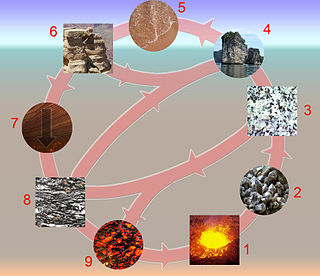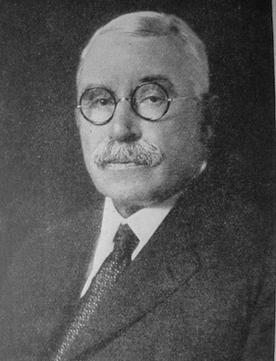Related Research Articles

A volcanologist, or volcano scientist, is a geologist who focuses on understanding the formation and eruptive activity of volcanoes. Volcanologists frequently visit volcanoes, sometimes active ones, to observe and monitor volcanic eruptions, collect eruptive products including tephra, rock and lava samples. One major focus of inquiry in recent times is the prediction of eruptions to alleviate the impact on surrounding populations and monitor natural hazards associated with volcanic activity. Geologists who research volcanic materials that make up the solid Earth are referred to as igneous petrologists.

Petrology is the branch of geology that studies rocks, their mineralogy, composition, texture, structure and the conditions under which they form. Petrology has three subdivisions: igneous, metamorphic, and sedimentary petrology. Igneous and metamorphic petrology are commonly taught together because both make heavy use of chemistry, chemical methods, and phase diagrams. Sedimentary petrology is commonly taught together with stratigraphy because it deals with the processes that form sedimentary rock. Modern sedimentary petrology is making increasing use of chemistry.

Peridotite ( PERR-ih-doh-tyte, pə-RID-ə-) is a dense, coarse-grained igneous rock consisting mostly of the silicate minerals olivine and pyroxene. Peridotite is ultramafic, as the rock contains less than 45% silica. It is high in magnesium (Mg2+), reflecting the high proportions of magnesium-rich olivine, with appreciable iron. Peridotite is derived from Earth's mantle, either as solid blocks and fragments, or as crystals accumulated from magmas that formed in the mantle. The compositions of peridotites from these layered igneous complexes vary widely, reflecting the relative proportions of pyroxenes, chromite, plagioclase, and amphibole.

The rock cycle is a basic concept in geology that describes transitions through geologic time among the three main rock types: sedimentary, metamorphic, and igneous. Each rock type is altered when it is forced out of its equilibrium conditions. For example, an igneous rock such as basalt may break down and dissolve when exposed to the atmosphere, or melt as it is subducted under a continent. Due to the driving forces of the rock cycle, plate tectonics and the water cycle, rocks do not remain in equilibrium and change as they encounter new environments. The rock cycle explains how the three rock types are related to each other, and how processes change from one type to another over time. This cyclical aspect makes rock change a geologic cycle and, on planets containing life, a biogeochemical cycle.
Cecil Edgar Tilley FRS, Hon FRSE, PGS was an Australian-British petrologist and geologist.
Alfred Edward "Ted" Ringwood FRS FAA was an Australian experimental geophysicist and geochemist, and the 1988 recipient of the Wollaston Medal.
Peter John Wyllie is a British petrologist and academic.
Pyrolite is a term used to characterize a model composition of the Earth's mantle. This model is based on that a pyrolite source can produce mid-ocean ridge basalts (MORB) by partial melting. It was first proposed by Ted Ringwood (1962) as being 1 part basalt and 4 parts harzburgite, but later was revised to being 1 part tholeiitic basalt and 3 parts dunite. The term is derived from the mineral names PYR-oxene and OL-ivine. However, whether pyrolite is entirely representative of the Earth's mantle remains debated.
Jonathan David Blundy FRS is Royal Society Research Professor at the School of Earth Sciences at the University of Oxford and honorary professor at the University of Bristol.
Charles R. Bacon is an American geologist and volcanologist at the United States Geological Survey in the Volcano Hazards Team, and who is best known for his work on the volcanic history of Crater Lake National Park and Mount Mazama.

Igneous rock, or magmatic rock, is one of the three main rock types, the others being sedimentary and metamorphic. Igneous rocks are formed through the cooling and solidification of magma or lava.

Bernard Elgey Leake is an English geologist. He is Emeritus Professor of Geology at the University of Glasgow, was Leverhulme Emeritus Fellow at Cardiff University 2000-2002 and has been an Honorary Research Fellow at Cardiff University since 1997.
Germaine Anne Joplin was an Australian geologist and winner of the Clarke Medal in 1963.

Charles Whitman Cross was an American geologist. He was educated at Amherst College, the University of Göttingen, and Leipzig University. A petrologist, much of his field work concerned rocks in Colorado. He and three other geologists proposed the CIPW norm that is still used in normative mineralogy. He was also active in scientific societies and institutions.

Timothy John Barrington Holland is a British petrologist who is Emeritus Professor in the Department of Earth Sciences at the University of Cambridge.
John Francis Lovering was an Australian geologist. He was Professor of Geology at the University of Melbourne from 1969 to 1987 and Vice-Chancellor of Flinders University from 1987 to 1995.
Thomas George Vallance was an Australian geologist, specializing in petrology, and a historian of geology. The Geological Society of London awarded him the 1993 Sue Tyler Friedman Medal.

Ikuo Kushiro MJA is a Japanese petrologist, known for his research in experimental petrology. His experiments on peridotites contributed significantly to the understanding of the formation of magma under mid-ocean ridges and island arcs.
Edward Manin Stolper is an American geologist, petrologist, and planetologist. He is known for his research on igneous rocks and volatiles in igneous processes, especially his research involving "pioneering experiments defining the behavior of volatiles in silicate melts and glasses."
References
- 1 2 "Vale Professor David Headley Green AM FAA FRS, 1936 – 2024". rst.org.au.
- ↑ "Trove". trove.nla.gov.au.
- 1 2 3 4 Centre for Transformative Innovation, Swinburne University of Technology. "Green, David Headley - Person - Encyclopedia of Australian Science and Innovation". www.eoas.info.
- 1 2 3 Green, David H. (2015). "The University of Tasmania and the Royal Society of London" – via University of Tasmania.
- 1 2 3 4 "Obituary - Professor David Green" – via Research School of Earth Sciences, ANU.
- ↑ "David Green". www.science.org.au.
- 1 2 Yaxley, G. M.; Brey, G. P. (October 11, 2007). "Foreword: The Roles of Petrology and Experimental Petrology in Understanding Global Tectonics". Journal of Petrology. 49 (4): 587–589. doi:10.1093/petrology/egn016.
- ↑ "2011 - David H. GREEN". mineralogy-ima.org. May 7, 2012.
- ↑ "David Headley Green" – via Canberra Times.